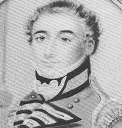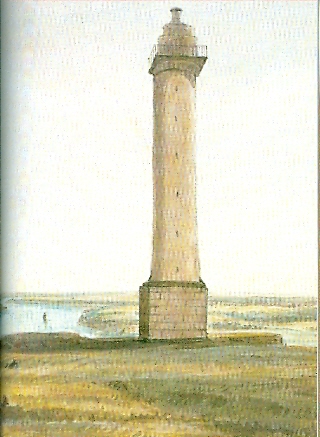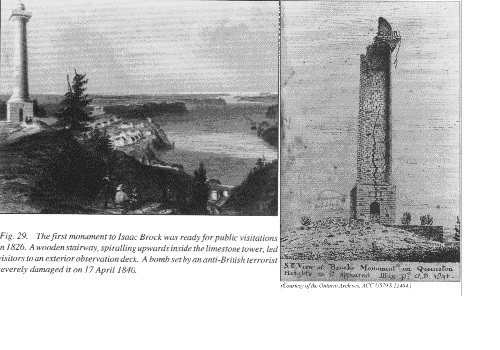
foreword | Historical Narratives | Resources | Links | Contact
REMEMBER BROCK, PART 3
"History is a chronicle of events."
 |
|
Sir Isaac Brock [Miniature by J. Hudson on Brock's last visit to England in 1806] |
"Though the dead heed not human praise, yet the living act wisely in commemorating the fall of a distinguished chief, and every posthumous honour should be paid to the memory of the man who merited so well this distinction."
Upper Canada acted on this advice. In the 55th year of George III's reign on the 14th of March, 1815, Members of the 6th Parliament, knowing that the inhabitants of the province reverenced Brock's memory and wanted to express their tribute with a lasting, public testimonial, passed into law "An Act to provide for the erection of a monument to the memory of the late President, Major-General Sir Isaac Brock." In the last session of the provincial parliament under his administration, Lieutenant-Governor Sir Gordon Drummond said it was his "unspeakable pleasure" to assent to this act.
With a further motion "to commemorate the great and brilliant services of Brock," the Legislature approved the sum of 500 pounds for the construction of a monument on the "Heights of Queenston near the spot where he fell."
The gratitude of the people of Canada who wished to perpetuate the remembrance of the man who saved the province, was to take an enduring form. While the hero and his deeds were still fresh in the memory of all, the Legislature's resolution would "commemorate the great and brilliant services" of Brock in some fitting way.
A year later a Monument Committee was appointed to oversee the project. Believing that the people of the province wished "to cherish the memory of so excellent a man and brave soldier," in a fitting fashion, the government granted a further sum of 1000 pounds "to complete the said monument upon a scale which appears to the commission, worthy of the subject."
Meanwhile in England, another honour was being bestowed upon Brock. William Brock, Isaac's eldest brother, was informed in a letter dated December, 1815 that "as a token of the respect which His Royal Highness the Prince Regent entertains for the memory of that officer," a commemorative medal had been approved.
Its design was to be large and beautifully executed in gold and worn suspended from the neck. On its obverse side was the name "Detroit" and on its reverse the figure of Britannia. Round the rim was the name Major-General Sir Isaac Brock. The medal was to be given only to principal officers who had served at Detroit, one of whom was Thomas Boucher de Boucherville, a militia officer on the Detroit frontier, who received this medal and a clasp for service as a militia officer under Brock at the capture of Fort Detroit. In Upper Canada in 1816 a medal was also struck in Brock's memory. On one side was depicted two angels hovering over his monument bearing the inscription: Fell Oct. 13, 1812. Around the rim were the words: Sir Isaac Brock The Hero of Upper Canada. On the reverse 1816 was inscribed in the centre and around the rim: Peace To The World Success to Commerce.Before making any decision regarding the Canadian monument, the Monument Committee decided to inquire of the Brock family what manner of memorial they wished to honour their illustrious brother. Two years passed before the family responded. They provided both a description of the memorial and the name of the sculptor they wished to sculpt it.
Savery Brock came to Upper Canada in 1817 to inform the Committee of the family's recommendations. The artist they proposed was Richard Westmacott, the noted English sculptor who had crafted Britain's memorial to Brock in St. Paul's Cathedral. The design the family had chosen was a 2.5 metre tall bronze statue of Brock atop a granite pedestal, on the base of which were depicted in bas relief, his actions at Detroit and Queenston. The structure's total height was 5.6 metres and was estimated to cost, including shipment to Canada, 2500 pounds. The Monument Committee found the price somewhat offsetting given that the expected influx of donations had not materialized. Finances were a continuing source of concern and for this and whatever other reasons, the Committee set aside the family's recommendations and opted to consider alternate proposals, all of which were deemed to be too expensive.
While Savery was in Upper Canada, he encountered Thomas Talbot at Fort George in August 1817.. He thought Talbot "a wonderful character" and visited him at Port Talbot where he remained Talbot's guest for eleven days. Savery was most impressed with "so fine a country" and with the works of Talbot, writing to his bother, "Could his Prince behold all he has done, he would bestow thanks and honours on him, for he has settled the country with judgment, zeal and activity, and of a perfect wilderness, he has laid in seven years the foundation of a populous and interesting country."
The Committee decided to invite submissions from interested artists, and from the two submitted, they selected one by a Scottish-trained engineer named Francis Hall. His design, estimated to cost 2200 pounds, was a Tuscan column surmounted by an ornament. Hall was placed in charge of the work and his account of 255 pounds was for "Plans and superintendence."
The following notice for tenders for the construction of the monument was inserted in the Upper Canada Gazette on November 4th, 1823.
MONUMENT IN MEMORY OF THE LATE MAJOR GENERAL SIR ISAAC BROCK ,K. B.
" The Commissioners for erecting the Monument voted by the Provincial Legislature, in memory of the late Major General Sir Isaac Brock, K.B., give notice that they are ready to receive proposals from any person or persons who may be desirous of contracting to execute the same. The Monument which is designed to be a Tower of cut-stone, fifty feet in height, and sixteen feet in diameter at the base with a winding stone stair inside and a vault underneath is to be erected on Queenston Heights on a scite (sic) to be pointed out by the Commissioners and to be commenced on the first of May next, and completed during the season. Stone and Lime, of a suitable quality, are abundant within half a mile of the place. A model of the intended Tower may be seen on application to any of the Commissioners, or to John Macaulay, Esq. Kingston.
THOMAS CLARK. )
THOMAS DICKSON, ) Commissioners.
ROBERT NICHOL, )
Niagara, Nov. 4th, 1823."
The land on Queenston Heights was according to tradition donated by John Chisholm. The gracefully proportioned Tuscun column of Queenston limestone stood on the rocky promontory high above the Niagara River. The monument's height from the base to the summit was 38.1 m. [135 ft.] From the level of the Niagara River nearby, it was 147.8 m. [485 ft.] It was to be a Tuscan column on a rustic pedestal with the diameter of the base of the column being 5.3 m. [17.5 ft.]. The capital was to be surmounted by an iron railing. The centre shaft containing the spiral stair case was 3.1 m. [10 ft.] in diameter.
Work was started on the monument in the spring of 1823. It was not completed exactly as designed and there is no record of its inauguration. At the base of the monument, there was a square enclosure which housed a lobby used by the keeper as a barroom.Inside the column were stairs that led to a gallery, near the top of which was an observation deck. The view from there was said to have been impressive, providing a particularly fine vista of Lake Ontario. The bar and the fine view from the top of the column of the winding river and the shiny lake beyond must have been popular, for one summer the keeper took in 35 pounds. The inscription on the base was nearly the same as the one on the existing monument.
The remains of General Brock and his gallant aide-de-camp, John Macdonell, were removed from the bastion at Fort George in preparation for their re-interment under the new monument on the Heights. Although twelve years had passed since the first burial, Brock's body, according to one observer, had undergone little change, his features still clearly discernible.
The weather on 13 October 1824, was remarkably fine and before ten o'clock an assemblage of 1000 citizens from all parts of the country had assembled on the plains of Niagara in front of Fort George in whose north-east bastion the remains of Brock and Macdonell had lain for twelve years. Among the many present according to Colonel James Fitzgibbon, one of Brock's officers in the 49th Regiment, were
In His Own Words"Numbers from the neighbouring State of New York, who by their presence and conduct proved how highly the Americans revered the memory of our lamented chief."
Brock's funeral, a three hour processional, was a scene of solemn splendour and martial pomp. The hearse (army wagon) with a black driver, contained the bodies covered with black cloth and drawn by four black horses, each of which was accompanied by a black soldier. Shortly after ten o'clock, a line was formed by the 1st and 4th regiments of Lincoln militia with their right on the gate of Fort George, and their left extending along the road to Queenston, the ranks being about forty paces from each other. Within this line was formed a guard of honour of the 76th Regiment of Foot in parade order, having its left on the fort. Soldiers of the 41st, the militia and 200 Indians formed the streeet along which the hearse moved slowly from the fort. To the sound of solemn music, a detachment of Royal Artillery began to fire the salute of nineteen guns.
The solemn procession took the following order:
A Staff Officer.
Sub-division of Grenadiers.
Band of Music.
Right wing of the 76th Regiment
The Bodies
Aide-de-camp to the late Major-General Sir Isaac Brock
Chief Mourners
Relatives of the late Lieutenant-Colonel Macdonell
Commissioners for the Monument
Heads of the Public Departments of the Civil Government
Judges
Members of the Executive Council
His Excellency the Governor and His Suite
Left wing of the 76th Regiment
Native Chiefs of the Six Nations
Officers of Militia not on duty, junior ranks first forward four deep
Magistrates and Civilians
A long cavalcade of horsemen and carriages of every description.
The column included Native chiefs, citizens and a long cavalcade of horsemen and carriages, three hundred vehicles each containing five persons. The time occupied in moving from Fort George to Queenston, a distance of nearly eleven kilometres, was about three hours. When the procession arrived opposite the spot where the lamented hero received his mortal wound, it halted and remained for a few minutes in solemn silence. It then ascended the Heights, where those awaiting had a wonderful view of the lengthy column slowly winding its way up the steep ascent, the many colours of the columns enhanced by the brilliant fall foliage. Twenty-four hundred troops and some 8000 civilians assembled around the grand monument on its commanding height, so fine, so fair, the view over the river and maple forest all aflame..
Once the bodies were removed from the hearse, they were deposited in the resting place prepared for them in the monument. The guard of honour presented arms whilst the artillery posted on the heights fired a salute of nineteen guns. The troops then marched in ordinary time around the monument and immediately separated to their respective parades.
Brock's body was interred in the vault and covered with stone slabs at the base of the 38 metre high column. Interred with him was his aide-de-camp, John Macdonell, whose remains lay to the left of those of the General. On the General's plain coffin there were two oval plates of silver. On the first was inscribed:
Here lie the remains of a brave and virtuous hero,
MAJOR GENERAL SIR ISAAC BROCK,
Commander of the British forces, and President administering Government of Upper Canada,
Who fell when gloriously engaging the enemies of his country at the head of the flank companies of the 49th Regiment,
In the Town of Queenston,
On the Morning of the 13th October, 1812,
Aged 42 Years.
J.B. Glegg, A.D.C.
On the second plate, the following additional inscription:
The remains of the late
Major-General Sir Isaac Brock, K.B.,
Removed from Fort George to this vault, on the 13th Oct. 1824.
Upon a similar plate on the lid of the aide-de-camp's coffin was engraved:
Aged 25 Years. The remains of
LIEUTENANT-COLONEL JOHN Macdonell,
Provincial Aide-de-camp to the late Major-General Brock,
Who died on the 14th of October 1812, of wounds received in action the day before.
Brock's monument on Queenston Heights was regarded by Upper Canadians with more affectionate respect than any other structure in the Province. It testified in a highly visible way (especially to Americans on the other side of the river) the adoration of Upper Canadians for the man deemed responsible for their survival.
In Their Own Words"The lofty column erected to his memory informs the world that patriotism still lives in Canada."
 |
|
Brock's First Monument |
Sixteen years later during the early morning hours of Good Friday, 17 April 1840, the lofty column was blown up, the heinous crime a "malicious act by band of felons." which filled the people with "one universal feeling od disgust and abhorrence." Benjamin Lett, an 1837 rebel, who was thought to have been the leading culprit, had fled to the United States.. A reporter noted:
In His Own Words"The pedestal was cracked on one side, the shaft of the column was extensively cracked in several places, and that portion of the column above the gallery was dreadfully shattered. The wooden staircase in side was blown into a mass of ruins."
A reward of 1000 pounds was offered but the perpetrators of the shocking act termed "a demon's deed" were never apprehended.
 |
|
Brock's First Monument [before & after] |
Copyright © 2013 Website Administrator